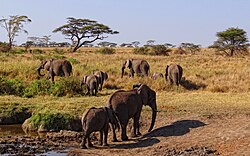The word savanna comes from a Panamanian word for prairie or plains. They are covered with tall grasses. They may have scattered bushes and trees, but not enough to keep grasses from growing.

One common example of a savanna is the tropical grassland, in Africa. They have seasonal rains and dry periods. All savanna plants and trees can survive periods of drought.[1] During the dry season the animals migrate north to countries on the East coast. Until the 20th century the elephant herds moving up the East coast were in the tens of thousands. They are far fewer today.
Some savannas get enough rain to support a forest, but the forest never happens because grazing keeps the trees from growing. Instead, there is lots of grasses and other plants that can regrow from the roots.[2]
Africa
changeThe savannas of Africa are the best known savannas. Some large herbivores found in the savanna are antelopes, impalas, gazelles, buffalos, wildebeests, zebras, rhinos, giraffes, elephants, and warthogs. Many large carnivores eat them, including cats (lions, leopards, cheetahs, servals), dogs (jackals, wild dogs), and hyenas. The vegetation in Eastern Africa is also rich with grass and some scattered trees, mostly acacia trees. The dry season is the winter: from December to February, it may not rain at all. But in the summer, there is lots of rain.[1]
Australia
changeNorthern Australia has a large savanna zone. This area includes northern Western Australia, the northern part of Northern Territory and eastern Queensland. Eucalyptus trees are the main tree in the Australian savanna. There are many species of kangaroos but not much else.[1] Some savannas in Australia have regularly spaced trees. They are sometimes known as "the bush".
Savannas in Australia can also be found in the southern parts of the country, from northeastern New South Wales in the subtropics to northern Victoria in the temperate zone. In the southwest, however, they change into chaparral (i.e. Mediterranean shrublands) and semi-desert bush.
North America
changeIn North America, the word savanna is also used to describe the tall grass prairies that have scattered trees, typically oaks. This is a temperate climate (colder than the tropics). It is called an oak savanna since the oak tree is the main tree. At least half of the view of the sky must be open. If there are more trees, then it is called a grove or a woodland. If there are fewer trees, it is a prairie. If there are many kinds of trees and brush and very little grass, then it is a forest.
Oak savannas are found in California and Oregon on the west coast. In the southwest it is found in Arizona, New Mexico, and northern Mexico. In the Midwest it is found in the tall-grass prairie. Often a grove or a savanna is east of a river, which stopped the fire often enough to let trees grow. Large oak trees will survive grass fires.
The savannas in the Midwest of the United States are kept open by regular fires, not because it is too dry for many trees.[3]
South America
changeBrazil's cerrado is an open woodland of short twisted trees. The are many kinds of plants and animals here, many that don't exist anywhere else on earth. The llanos of the Orinoco basin of Venezuela and Colombia are grass savannas, some parts of it get flooded every year.
References
change- ↑ 1.0 1.1 1.2 "World Savanna Biomes". BluePlanetBiomes. Retrieved 27 April 2013.
- ↑ "Tropical savannas". Radford University. Retrieved 27 April 2013.
- ↑ "Oak Savannas - characteristics and restoration". OakSavanna.org. Archived from the original on 15 June 2013. Retrieved 27 April 2013.